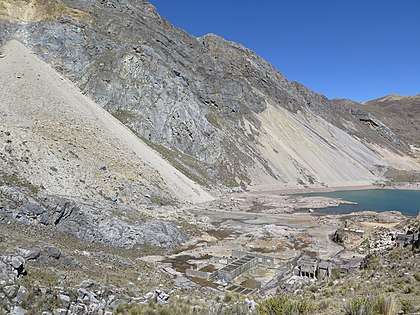Chungar Mine
The Chungar Mine, inactive, exploited a polymetallic (Zn-Pb-Cu-Ag) skarn deposit in the high Andes of central Peru. It is located about 116 km NE of Lima, 57 km southwest of Cerro de Pasco, and 82 km northwest of La Oroya in the (Santa Cruz de Andamarca District, Huaral Province, Lima Region, 11°07′27″S 76°31′56″W, 4380 m.a.s.l.). In 1971, a landslide-generated wave ("landslide tsunami" [1]) at the Yanawayin Lake destroyed most of the surface facilities and killed 200-600 persons [2][3], including miners in flooded underground workings [3].



The mine was owned by Cia. Minera Chungar, S.A.C. After the 1971 disaster, this mining company, keeping the same name, transferred the operations 16 km NE to the Animón mine in the Huarón Mining District.
Between 1995 and 2008, Compañía Minera Cerro S.A. rehabilitated some underground workings and had a small scale operation.
Since 2015, the mining company Volcan is exploring the surroundings of the Chungar Mine (Romina project) including the Puagjanca area where a Zn-Pb-(Ag) ore body was discovered[4].
Confusion on the term "Chungar Mine"
The mining company Volcan through its now subsidiary Compañía Minera Chungar S.A.C.[5], operates the polymetallic Animón and Islay mines, in the Huarón Mining District, located 16 km NE of the actual Chungar Mine, under the term "Mining Unit Chungar"[6] (Unidad minera Chungar[7]). The use by Volcan of this term "Chungar Mining Unit"[6][7][8] has caused some confusion, and certain sources (e.g., the data base "alicia.concytec.gob.pe"[9] and a WoodMackenzie Report[10]) use wrongly the term of "Chungar mine" for the Animón mine.
Geological Frame
The Chungar skarn deposit belongs to the Miocene polymetallic belt of Central Peru [11]. The skarn Zn-Pb-Cu-Ag mineralization occurs mainly at the western contact of the Chungar Granite with limestone of the Cretaceous Jumasha Formation and in roof pendants[12]. Ore consists mainly of sphalerite, galena, chalcopyrite, and pyrrhotite in andradite skarn[12]. Age determinations on the outcropping Chungar granite yield an age of 12.88 ± 0.36 Ma (Ar/Ar biotite plateau age) [13] that is consistent with previous K-Ar age determinations[12].
Similar skarn occurrences are known north and south of the Chungar Mine (e.g. Don Miguel prospect, 11°03′00″S 76°33′25″W, 8 km north of the Chungar Mine and 1 km E of the Chalhuacocha granodiorite, which was K-Ar dated at 10.0±0.3 Ma on biotite[12], and the Puagjanca ore body, 4 km to the south [4]).
References
- https://www.usgs.gov/faqs/how-do-landslides-cause-tsunamis?qt-news_science_products=0#qt-news_science_products landslide tsunamis, USGS, retrieved on April 15, 2020
- Robert B. Jansen, ed. (1988). Advanced Dam Engineering for Design, Construction, and Rehabilitation. Google Books. Springer. p. 739. ISBN 978-0-442-24397-5. Retrieved 4 May 2014.
- Plafker, George; Eyzaguirre, V. Z. (1 January 1979). "7: Rock Avalanche and Wave at Chungar, Peru". In Barry Voight (ed.). Engineering Sites: Rockslides and Avalanches (1 ed.). Elsevier. pp. 269–279. ISBN 0-444-59801-4. Retrieved 4 May 2014.
- Volcan 2019; Memoria Anual 2018; 199 p.
- Company profile Compañía Minera Chungar S.A.C.,bnamericas.com, retrieved on April 6, 2020
- Volcan, Mining units, retrieved on April 6, 2020
- Volcan, Unidades Mineras, retrieved on April 6, 2020
- miningdataonline
- Data Base "alicia.concytec.gob.pe" retrieved on April 6, 2020
- Chungar zinc mine, WoodMackenzie Report, retrieved on April 6, 2020
- Noble, D. C., & McKee, E. H. (1999). The Miocene metallogenic belt of central and northern Peru. In: Geology and ore deposits of the Central Andes. Special Publication SEG, v. 7, p. 155–193.
- Soler, P., & Bonhomme, M. G. (1988). Oligocene magmatic activity and associated mineralization in the polymetallic belt of Central Peru. Economic Geology v. 83, 657-663.
- Bissig, T., Ullrich, T. D., Tosdal, R. M., Friedman, R., & Ebert, S. (2008). The time-space distribution of Eocene to Miocene magmatism in the central Peruvian polymetallic province and its metallogenetic implications. Journal of South American Earth Sciences, 26(1), 16–35. http://doi.org/10.1016/j.jsames.2008.03.004